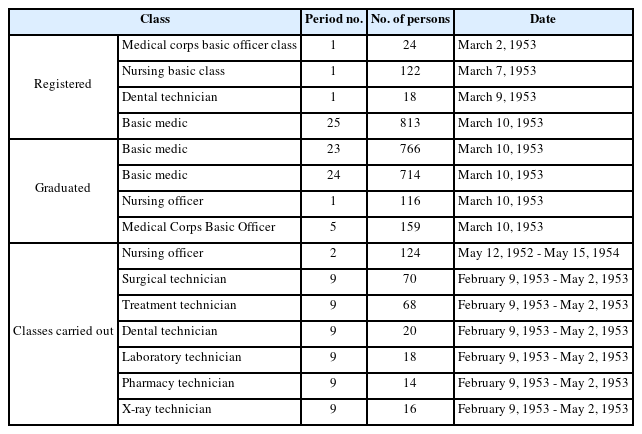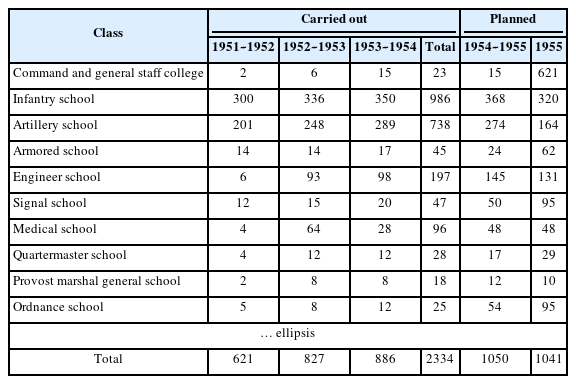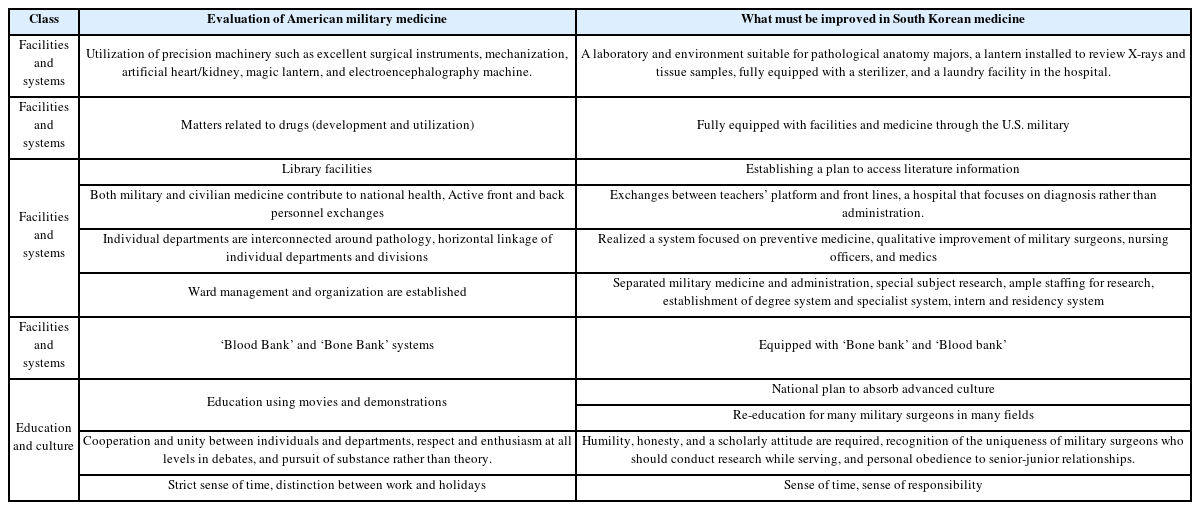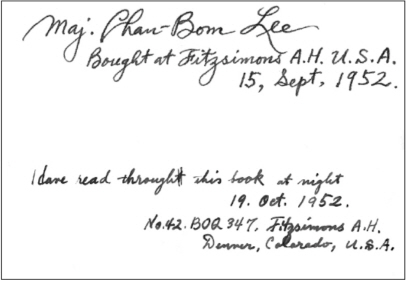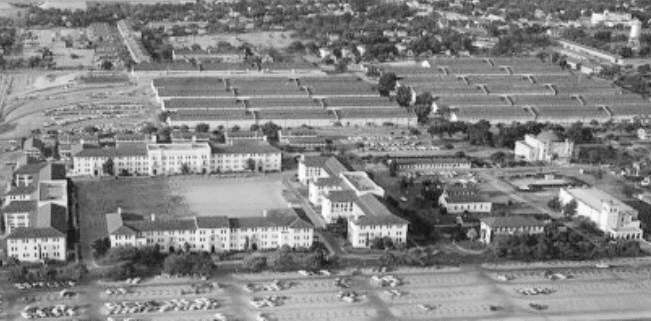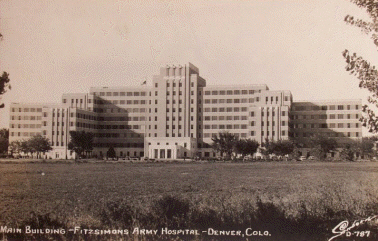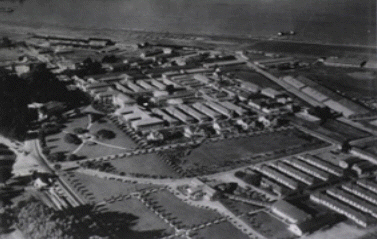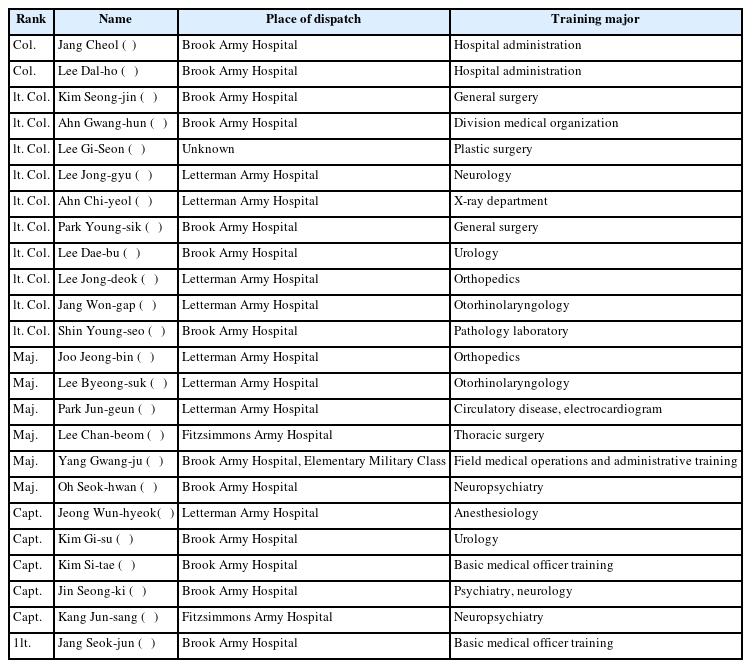Development and Influence of Military Medicine during the Korean War: the Medical Field Service School and Training in the U.S.†
Article information
Abstract
This study investigates the development of military medicine during the Korean War, with a focus on the role of the Medical Field Service School and training programs in the United States. It also explores the nuanced acceptance of American medicine by South Korean doctors. Military surgeon education and training emerged as pivotal catalysts, initiating a qualitative transformation in South Korean medicine and serving as a catalyst for the advancement of modern medical practices.
Military surgeon education went beyond imparting military knowledge to civilian doctors; it also acted as a vehicle for disseminating fundamental medical knowledge essential for the progress of Korean medicine. Noteworthy is the strategic selection of exceptional military surgeons for overseas training, serving as a vital link for the assimilation of ‘advanced medicine’ across diverse medical domains.
Contrary to unilateral acceptance, South Korean doctors embraced American medicine based on subjective judgments aligned with the specific needs of South Korean medicine. Acknowledging American medical knowledge and technology through the Medical Field Service School and U.S. training, military surgeons refrained from mere praise, recognizing the substantial gaps between South Korean and American military medicine. Beyond material achievements, South Korean military surgeons also discerned and valued the spiritual legacy of American medicine.
These military surgeons actively determined the essential medical majors for South Korea, introducing cutting-edge medical technology, and leveraging relationships with U.S. military surgeons to facilitate opportunities for themselves and their students to study abroad. This proactive approach highlights the independent thought processes of South Korean military surgeons, addressing both material and spiritual needs and serving as internal driving forces for the development of South Korean medicine.
1. Introduction
The rapid advancement of modern South Korean medicine over the past half-century was the result of its active acceptance of American medicine since the liberation (Park, 2021; Choi, 1996). In the period of about 140 years since the establishment of Western-style modern hospitals, South Korean medicine has evolved significantly, progressing from the initial stages of educating and cultivating Korean medical professionals to its current state characterized by substantial quantitative research output. Notably, as of 2019, South Korea contributed approximately 3.9% (12,954 papers) of Science Citation Index (SCI) articles in the field of clinical medicine worldwide, securing the 10th position globally.1)
During the colonial period, medical research in Korea was predominantly led by Japanese doctors, and the primary focus of Korean medical education was patient care.2) The subsequent remarkable development of South Korean medical research post-liberation can be better comprehended by acknowledging the support extended by the United States. In recent times, South Korean medicine has not only benefitted from but has also reciprocated in its relationship with American medicine. Initially a recipient of the ‘Seoul National University-Minnesota Project’ in the late 1950s, South Korean medicine has now become a provider of medical technology training to the University of Minnesota Hospital in 2015.3) As South Korean medicine transcends the historical influence of the United States, it becomes imperative to delve deeper into internal driving forces that have shaped its development.
This study aims to underscore the pivotal role of military surgeons in the acceptance of ‘advanced medicine’ through their training at the Medical Field Service School during the Korean War. Despite the significance of military surgeons’ experiences in shaping South Korean medicine, this group has received limited attention in previous research. Notable exceptions include studies on the wartime evacuation system, the low level of military medical knowledge among military surgeons (Kang and Park, 2023), and other related studies (Shin, 2022; Han, 2021). Studies on the acceptance of ‘American medicine’ have predominantly focused on public health students rather than clinical medicine (Kim, 2023; Kwon, 2017; Lee, 2020; Park and Hwang, 2021; Park, 2022), with minimal emphasis on the collective impact of doctors as principal agents in medical research and acceptance.
To explore the education and training of military surgeons in the U.S., this study leverages materials from the U.S. National Archives and Records Administration (NARA), specifically those related to the Korea Military Advisory Group and the Medical Field Service School. Key to the investigation is the Medical Journal of the ROK Army, a valuable resource containing questionnaire surveys that capture the reflections of military surgeons post-training in the U.S. These surveys offer insights into the military surgeons’ comprehension of ‘advanced medicine’ and their awareness of the South Korean medical environment. The examination of these materials will contribute to a comprehensive understanding of the role played by military surgeons in the development of South Korean medicine.4)
2. Military medicine and the Medical Field Service School
Before the onset of the Korean War, military medicine occupied a peripheral position within the realm of South Korean medicine. The establishment of the National Defense Guard on January 14, 1946, precipitated the creation of the Medical Affairs Bureau under the Department of Internal Security in June of the same year.5) Renowned figures such as Shin Hak-jin (申鶴鎭) and Park Dong-gyun (朴東均), former medical officers in the Japanese Manchurian Army before liberation in 1945, played instrumental roles in the formation of the early medical corps.
However, the South Korean medical community exhibited a lack of appreciation for the role and significance of ‘military medicine’ during this period. The profession of a military surgeon was not regarded favorably, with instances of professors becoming military surgeons driven by school politics rather than a voluntary commitment before the Korean War (Kim, 2021: 165). This trend was exacerbated by ideological conflicts during the integration of Seoul National University’s medical school, leading to critiques that their ideological tendencies did not align with the national identity.
Trust in military hospitals was notably low, as revealed by Yun Chi-wang (尹致旺)’s recollections, who served as Army Surgeon General during the Korean War.6) Military expenses were allocated to private medical institutions rather than military hospitals, reflecting a lack of confidence in the latter. This stemmed from both the perceived inadequacy of skilled military surgeons and a general distrust among officers in military medical institutions.7)
The Korean War brought about a significant shift, elevating the status of ‘military medicine’ from the periphery to the center of the South Korean medical community. Compulsory military service during the war compelled medical school professors and third- and fourth-year regular students to join the military, thereby altering the community’s focal point. This period witnessed a substantial transfer of executives from the Korean Medical Association to military service, diminishing academic activities in the private medical community but invigorating those within the military.8)
The content and meaning of ‘military medicine’ underwent a transformative phase, marked by a heightened emphasis on advanced medical technology. Preceding the war, military medicine barely encapsulated the rudimentary concept of “medicine studied by military doctors,” leading military surgeons to express concerns about the potential erosion of knowledge acquired at medical education institutions due to inadequate medical education.9)
However, the ensuing post-war era assigned military surgeon groups the responsibility of enhancing the level of the ‘underdeveloped’ South Korean medicine by assimilating ‘advanced’ medical technology. This transition was epitomized by the establishment of the Army Medical Officers Corps with the Army Regulation No. 44 on November 9, 1953, which comprised various medical professionals and aimed at significantly improving outdated medical technology. Shin Hak-jin, the Surgeon General of the Army Headquarters, said that the purpose of establishing the Army Medical Officer Corps was to “highly improve the outdated medical technology,” thereby “promoting good-fellowship and unity,” and serving by cultivating the “spirit of philanthropy based on humanitarianism.”10))
Furthermore, military medicine assumed the mission of leading South Korean medicine. The Army Medical Officers Corps Magazine, founded with the purpose of acquiring and exchanging new medical technologies, sought to be not only a magazine for the Army Medical Corps but also a representative publication for the broader South Korean medical community.11) This journal aimed to compile research activities, serve as a professional magazine representing the South Korean medical community, and act as a conduit for acquiring overseas knowledge.
Expectations for the role of military medicine were also articulated by Shim Ho-seop (沈浩燮), the president of the Korean Medical Association. In his congratulatory speech for the founding of the Army Medical Officer Corps, he emphasized the necessity for energetic research in the military, where many doctors and scholars concentrated their efforts and abundant facilities and resources for research were available.12)
The South Korean medical community’s expectations for military medicine were closely tied to changes in military medical education during the war. The United States, revising its strategy for the Korean War in May 1951, witnessed a shift in the role of the military advisory group from supporting combat operations to emphasizing education and training. Military surgeon training gained momentum as the front lines became deadlocked in early 1952, reflecting a strategic pivot in U.S. objectives (Kim, 2016).13)
The revitalization of the Medical Field Service School culminated in the establishment of officer courses within the broader framework of medical field service schools. Originally founded on August 15, 1949, the Medical Field Service School underwent a significant reorganization, transforming into a field medical corps immediately following the outbreak of war. Its primary mission encompassed the treatment and evacuation of wounded personnel situated in combat units at the forefront of military operations.14)
A pivotal development occurred on November 7, 1950, when the Medical Field Service School underwent reinstatement, marking the commencement of basic combat medic training.15) Subsequently, from March 10, 1951, onward, the institution expanded its educational repertoire by introducing six technical courses. Notable among these were the “Medical Officer and Medic Basic Course” and the “Internal Medicine Technical Sergeant Course.” The unfolding chronicle continued with the establishment of the “Military Surgeon Elementary Military Class Course” on January 28, 1952, and the inauguration of the Medical Administration Officer Candidate Course on March 10 of the same year. A comprehensive exposition of the training courses administered by the Medical Field Service School, as of March 1953, is meticulously detailed in <Table 1>.16)
The overarching objective of the Medical Field Service School was to equip medical officers and medics with the competencies necessary for the execution of military duties during both wartime and peacetime. Officers and candidates enrolled in the Medical Field Service School were mandated to cultivate leadership attributes essential for officers, coupled with a commitment to professionalism. A comprehensive skill set was emphasized, requiring medical officers to possess knowledge spanning the domains of military strategy and medical command. Their management and command abilities were anticipated to be of practical utility, particularly in scenarios demanding emergency mobilization. The training curriculum encompassed a diverse array of methodologies, including lectures, academic conferences addressing medical, tactical, and administrative expertise, field education, and practical training. Following foundational education, individuals underwent professional technical training tailored to their specific aptitude, ability, civilian education, and occupational experience.17)
The Office of the Surgeon General of the South Korean Army allocated and selected officer and soldier students to be educated at the Medical Field Service School (<Table 1>), and recommended officers and soldiers to be in charge of education and operation at the Medical Field Service School (<Table 2>).
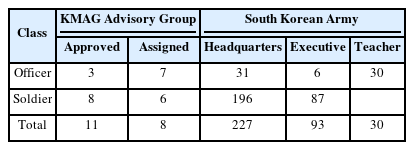
Educational and administrative personnel assigned to the South Korean Army Medical Field Service School (February 4-10, 1952)
The estimation of military surgeons educated at the Medical Field Service School spans a range from 1,085 to 1,952 individuals. A comprehensive research, drawing upon military advisory group documents, disclosed that, as of July 1953, the number of officers emerging from the Medical Field Service School comprised 1,085 from the basic officer course and 867 from the special course. In the scenario where the completion of the special course is contingent upon finishing the basic course, the minimum count of individuals who successfully concluded the Medical Field Service School curriculum stands at 1,085. Alternatively, if the two courses were pursued independently, the maximum count of individuals educated for the role of military surgeon would be 1,952.
Achieving proximity to the maximum estimated count of 1,952 military surgeons who completed the Medical Field Service School curriculum is challenging, as evidenced by the actual post-armistice count of 1,649 actively serving military surgeons.18) A substantial portion completed both basic officer and special courses. Post-armistice, military surgeons constituted approximately 27% of the total Western medicine practitioner population in South Korea, encompassing doctors with regional limitations in their practice.
Along with the Medical Field Service School, the United Nations Military Hospitals conducted training for South Korean military surgeons. Between 1951 and 1952, the surgeons were strategically deployed to various UN Forces units based on their specializations. For instance, four anesthetists were dispatched to the US Army’s 8209th Surgical Hospital, 14 specialists in “war limb (戰肢)” amputation to an Indian unit, three thoracic surgeons to the US P.O.W camp, three “brain surgeons” to the Danish hospital ship, and three “neuropsychiatrist military surgeons” to both the Danish hospital ship and three surgeons to the US Army’s 6th Surgical Hospital. The training duration for these military surgeons ranged from 2 weeks to 1 month.19) Additionally, medical societies were established for military surgeons to discuss clinical cases arising during the war, with participation from both South Korean officers and UN forces.20)
In conclusion, during the period of the Korean War, military surgeons improved the medical knowledge through the Medical Field Service School. Wartime medical education generally expanded the existing continuing education. In addition, the strategic deployment of certain military surgeons to UN military hospitals with participation in medical conferences facilitated the acquisition of ‘advanced’ medical knowledge.
3. Military surgeons and their medical skills
1) Selection of military surgeon trainees and their dispatch to the U.S.
The training conducted in the United States afforded military surgeons a firsthand exposure to ‘advanced’ American medicine. On September 11, 1951, Minister of National Defense Lee Ki-poong (李起鵬) presented a proposal to enhance the capabilities of the South Korean army to U.S. Ambassador Mucho. This proposal encompassed a comprehensive plan for the study and training of South Korean military surgeons at U.S. Army and Navy medical centers.21)
Lee Ki-poong’s proposition aligned with the policy of the South Korean government, which had persistently advocated for the expansion of 10 additional divisions and the bolstering of the South Korean military through the incorporation of 500,000 armed members from the Korean Youth Corps.22) The imperative for augmenting the medical manpower within South Korean military divisions became apparent, given their inadequacy in size.
The decision to reinforce the South Korean military with 10 divisions, finalized at the close of 1952, prompted considerations for the expansion of the advisory group. This expansion was deemed necessary as the training of the South Korean military assumed heightened significance to counteract potential deterioration in the quality of military surgeons attributable to the escalating number of South Korean troops.23)
The eighth US army, recognizing the imperative to enhance the combat efficiency of the Korean military, endorsed an extensive officer training initiative (Kim, 2016). A specialized training program targeting infantry, artillery officers, and military surgeons, etc. was implemented. From 1951 to 1954, 96 military surgeons were trained in the U.S.A., constituting 5 to 10% of Medical Field Service School graduates during the wartime period. Post-1954 (~1955), the plan aimed to annually dispatch 48 military surgeons (see <Table 3>).
Military surgeons seeking training in the U.S. underwent a preliminary examination, with 240 applicants for the <Preliminary Examination for Medical Officers to Study in the US> on June 8, 1953. However, only 109 individuals participated in the exam,24) and the final successful candidates amounted to 28 (see <Table 3>). This equated to approximately 12% of all training applicants, signifying a selective process for dispatch to the U.S..
While the reasons for the fewer examinees than applicants are not explicitly elucidated, potential motivations might include individuals opting for private medical practice upon military discharge25) or concerns about the English proficiency test component within the preliminary examination. Notably, anxiety over English abilities transcended specialized subjects, a sentiment shared among military surgeons and other applicants.
Despite such concerns, undertaking training in the United States was perceived as an exceptional opportunity for military surgeons. The prowess of American medicine, demonstrated during the war in terms of techniques, pharmaceuticals, and systems, fostered a growing desire among South Korean doctors to study and train in the United States. This sentiment is exemplified by anecdotes, such as a medical student recalling the awe and respect accorded to a doctor returning from the U.S. during the 1950s. This admiration underscored the perceived prestige associated with U.S. education, leaving an indelible mark on the memory of those aspiring to advance their medical careers.26)
The subsequent analysis will concentrate on individuals identifiable among those dispatched to the United States for training. A survey published in the Medical Journal of the ROK Army (1954) highlighted 24 officers sent for training in 1953 (see <Appendix>).
The 24 military surgeons were allocated to specific schools and hospitals, and these assignments were categorized into three groups (see <Table 4>). These institutions corresponded to three of the eight hospitals where the U.S. military operated a military surgeon intern and residency system in 1947. Significantly, these hospitals were accredited by members of the American Medical Association’s Medical Education and Hospital Committee, serving as expansive general hospitals encompassing a wide array of clinical specialties.27)
Thirteen military surgeons were deployed to the US Army’s Fort Sam Houston Medical Field Service School (MFSS) and the Brooke General Hospital, located at San Antonio, Texas. The Brooke General Hospital, established in 1886 originated as a U.S. military “station hospital” and expanded significantly after World War II. By 1944, the hospital boasted 7,800 beds. And the Medical Field Service School, initially opened in Carlisle Barracks, Pennsylvania, in 1921, was relocated to Fort Sam Houston in 1946 due to increased demand for transitioning civilians into soldiers.29) The MFSS & Brooke General Hospital earned the name of “home of Army Medicine.”30) Given the pivotal role of Brooke General Hospital in U.S. military medicine, all South Korean military surgeons specializing in administration were assigned there. Moreover, trainees from various clinical fields, including surgery, urology, neuropsychiatry, and pathology, were dispatched due to the hospital’s comprehensive coverage of clinical disciplines.
Letterman Army General Hospital, situated in San Francisco, California, was the second general hospital established by the U.S. Army in 1898. This hospital played a role in treating war wounded during World War II, particularly handling a large number of trauma patients transported to the U.S. mainland. By 1945, the hospital boasted 3,500 beds and accommodated 122 military doctors, 90 nurses, and 1,700 medics.31) The eight Korean military surgeons dispatched to this hospital specialized in orthopedics, anesthesiology, radiology, neurology, otolaryngology, and cardiology.
The Fitzsimons Army Hospital, located in Aurora, Colorado, was established in 1918 during World War I as the 21st General Hospital, primarily dedicated to the treatment of tuberculosis. With the onset of World War II and the evacuation of war wounded to this hospital, the bed capacity was expanded to 3,500. Transitioning from its previous emphasis on tuberculosis patients, the hospital redirected its focus to the treatment of lung cancer and chest diseases starting in the 1950s.35) Two military surgeons, specializing in thoracic surgery and neuropsychiatry, were deployed to the Fitzsimons Army Hospital.
2) Evaluation and prospects of South Korean military medicine
The survey administered to the 24 U.S. military trainees comprised inquiries such as “what aspects of U.S. military medicine and facilities left a significant impression” and “what aspects in South Korea’s medical environment require urgent improvement.” This aimed to discern disparities perceived by the trainees between South Korean and U.S. medical practices and gather assessments of both healthcare systems by the trainees themselves, as delineated in <Table 5>. The ensuing sections succinctly present relevant excerpts derived from the survey responses.36)
In terms of facilities, South Korean trainees highlighted keywords such as “accurate,” “scientific,” “abundant,” “completely equipped,” “magnificent,” “economical,” and “effective” when describing American military medicine. American medical facilities, with their precision machinery and advanced technologies, left a lasting impression on Korean officers, who often faced shortages of medical supplies in Korea. The trainees were particularly impressed by the use of innovative medical equipment, such as artificial hearts and kidneys, as well as data-based diagnostic tools like slide projectors and electroencephalography devices.
The advanced facilities of American military medicine revealed a stark contrast to the limitations of South Korean medicine. While the trainees praised the American system, they acknowledged the challenges of immediate adoption in Korea due to economic constraints. Despite recognizing the gap, the trainees emphasized the need for change in South Korean medicine based on the experiences gained from American military medicine.
At the institutional level, the trainees noted the keywords “cooperation,” “linkage,” and “cooperation” in American military medicine for diagnosis and treatment. Unlike South Korea, where military and civilian medicine operated separately, the U.S. system integrated both, fostering cooperation and coordination among various medical departments. The key role played by pathology in the U.S. was highlighted, and the trainees recognized pathology as a specialty essential for South Korean medicine. The ‘Blood Bank’ and ‘Bone Bank’ systems were also identified as crucial for preparing for the treatment of war-injured patients.
While the trainees expressed a desire to introduce American medical equipment into South Korea, they acknowledged the need for a realistic approach, emphasizing the importance of systemic, institutional, and educational reforms. Suggestions included the establishment of a general hospital system, retraining of military surgeons, intern and resident programs, and increased participation in conferences and symposiums. The trainees also raised concerns about the lack of focus on patient treatment in the South Korean military medical community, proposing the relief of administrative work to prioritize patient care.
At the cultural level, the trainees pointed out “unity,” “public-private division,” and mutual “respect” within the organization in American military medicine. The academic mindset, sense of responsibility, and the need for a sense of time were aspects of American military medicine’s cultural legacy that impressed the trainees. They proposed the creation of a Korean military medicine culture aligned with the principles of American military medicine.
In summary, the military surgeons trained in the U.S.A. identified areas for South Korean medicine to develop in terms of facilities, systems, education, and cultural aspects. While admiring the advanced medical technology and facilities of American military medicine, the trainees acknowledged the challenges of immediate implementation in South Korea. Their recommendations focused on systemic reforms, institutional changes, educational improvements, and the cultivation of a medical culture aligned with American practices. The experiences of these military surgeons contributed to the ‘Americanization’ of South Korean medical education, shaping a new orientation toward advanced medicine.
Meanwhile, certain trainees conveyed sentiments of inferiority, and while the content may not be directly linked to the enhancement of South Korean medicine, it remains noteworthy for its implications in examining the perceived medical disparity between South Korea and the United States. This observation is particularly significant within the context of the prevailing orientation toward advanced medicine. One trainee, Jang Seok-jun, articulated an awareness of “ethnic discrimination.” For him, ethnic discrimination was construed as an inevitable impetus, a “natural phenomenon” stemming from artificial differentials in power and wealth. Individuals grappling with this sense of inferiority tended to coalesce, and the international manifestation of this sentiment was identified as ethnic discrimination.
Jang Seok-jun’s conclusion posited that understanding and studying Americans’ psychology, life, thoughts, and behavior were imperative. He actively transformed his feelings of inferiority into a pursuit of assimilation. Interestingly, he did not perceive ethnic discrimination as a negative emotion arising from conflicts between ethnic groups and countries. Instead, he regarded it as an “irresistible” impetus driving the need to comprehend and assimilate the culture of advanced countries. Nevertheless, caution must be exercised in critically appraising this perception, considering that American modernizationists, influenced by the theory of evolution, tended to accept the inherent inequality of classes and capital (Michael Latham trans., 2021: 130). A critical consideration is warranted to prevent potential expansion into notions of ‘development supremacy.’
In conjunction with the experiences of military surgeons trained at U.S. Medical Field Service Schools and hospitals, the consciousness of a young military surgeon, transforming even the inferiority complex associated with ethnic discrimination into an orientation toward advanced medicine, played a role in the ‘Americanization’ of the foundation of South Korean medical education.
4. Experience in military medicine and its impact
1) Changes to majors and acceptance of medical technology
During the Korean War, significant advancements occurred in various department of modern medicine in South Korea. Military surgeons, dispatched to hospitals participating in the conflict as UN forces, underwent training and collaborated with foreign medical officers possessing advanced surgical techniques in field medical units. This experience notably spurred the development of surgery, anesthesiology, emergency medicine, and rehabilitation medicine, essential disciplines during wartime (Park, 2021: 70-74).
The medical proficiency of U.S. military surgeons stationed in Korea garnered high praise. A South Korean military surgeon, Lee Yong-gak (李容珏),37) stationed in Munsan with the 5th Medical Company, acknowledged the superior first aid skills of U.S. military medics and highlighted the exceptional medical skills of military surgeons who had been residents at American universities before conscription. Frank C. Spencer,38) a notable figure in surgical history, was cited for his innovative large-scale arterial transplants, preventing leg amputations by reinserting arteries harvested from fallen soldiers (Lee, 1997: 121).
Confronted with the remarkable medical technology and advanced knowledge of U.S. military surgeons, many South Korean doctors altered their specialties. Surgery, anesthesiology, and pathology emerged as popular choices for those seeking to emulate the expertise witnessed during the war. Individuals like Lee Yong-gak, originally a microbiology major, transitioned to surgery, while Yoo Seung-heon (劉承憲)39) shifted from obstetrics and gynecology to anesthesiology after recognizing its role in various surgeries (Yoo, 1997: 42). The importance of clinical pathology, previously absent in South Korea, became apparent, leading to the introduction of this specialty. Military surgeons, including Kim Kihong (金箕洪), professor at Su-do medical college in 1960 and at college of medicine Hanyang University in 1972, and Kim Hyo-gyu, professor at college of medicine Yonsei University underwent specialized training in the U.S. and subsequently contributed to the establishment and development of clinical pathology in South Korea (Park, 2016: 112).
In addition to introducing new disciplines, detailed technologies were transferred during this period. Lee Yu-bok (李有福),40) a student of the 7th class of the Medical Field Service School, recalled comprehensive education on military medical care and command-related knowledge. Notably, he received instruction on cutting-edge biochemistry, including the use of ‘paper chromatography’ for component separation, a technique recognized with the Nobel Prize in Chemistry in 1952 (Lee, 2006: 60-61). Such advancements in medical technology were disseminated through the Medical Field Service School, influencing individuals like Lee Yu-bok to shift their focus to pathology.
A noteworthy illustration of the acceptance of medical technology during military surgeon training is exemplified by Lee Chan-beom. As depicted in <Figure 4>, Lee Chan-beom left a notation inside the cover of the book “Heart Surgery,” indicating his reading of the book at Fitzsimmons Army Hospital in Denver, Colorado, USA, on the night of October 19, 1952 (Kim, 2009). Merely a year later, Lee Chan-beom achieved the distinction of being the first individual in Korea to successfully conduct a lung resection. In an era when specialized medical literature was scarce in Korea, Lee Chan-beom’s access to such resources in the United States during his military surgeon training significantly contributed to the subsequent advancement of his medical expertise.
Post-war, South Korean military surgeons assumed pivotal roles across various domains within the South Korean medicine. Confronted with the practices of American military medicine, they diligently contemplated the requisite specializations for the Korean context. Consequently, they reoriented their professional focus toward fields such as neurosurgery, pathology, and anesthesiology, characterized by emerging skills essential in the Korean medical milieu. Moreover, the medical knowledge acquired from UN Army surgeons and during U.S.-based training laid a robust foundation. This knowledge proved instrumental in the subsequent development of clinical practice and foundational medicine by South Korean military surgeons.
2) Formation of overseas networks and the expansion of study abroad
The knowledge exchange with the UN forces stationed in Korea wielded an impact akin to that of South Korean military surgeons undertaking foreign studies. Beyond the transmission of medical knowledge, this exchange facilitated the establishment of human networks with overseas medical scholars, thereby laying the relational groundwork for the subsequent advancement of South Korean medicine.
Lee Yong-gak, having associated with approximately 30 military surgeons during the war, noted that many of them ascended to professorial positions at prestigious American universities. Spencer, renowned for his groundbreaking arterial surgery, notably assumed the role of chief professor of surgery at New York University (Lee, 1997: 120-121, 125).
Personal relationships played a role in shaping the trajectory of South Korean military surgeons seeking to study in the United States. Lee Yonggak, aspiring to pursue studies in the U.S., leveraged his connections within the 5th Medical Company, ultimately securing a study abroad opportunity at Texas Medical Center Methodist Hospital through the assistance of military surgeon Luis E. Shirley (Lee, 1997: 120-121, 130). Moon Tae-jun (文太俊)41) and Lee Heon-jae (李憲梓),42) stationed at the 36th Army Hospital, similarly tapped into their connections with U.S. military surgeons to facilitate their study abroad ventures in the United States (Moon, 1997: 55, 60).
These relationships continued to wield influence even after the war. Roughly two decades later, Lee Yong-gak enlisted Professor Spencer’s assistance to facilitate overseas training for his student—Professors Kim In-cheol (金仁哲) who later became the directors of Gangnam St. Mary’s Hospital, and Ko Yong-bok (高龍福) were among those who benefitted from this arrangement (Lee, 1997: 122). The enduring impact of these connections extended beyond military surgeons and their students, as many military surgeons assumed professorial roles upon their return. The experience of U.S. training significantly augmented the social and academic influence of these military surgeons, culminating in their role as advocates for changes in the reorganization of South Korean medical education.
In the late 1950s, the surge in the number of doctors studying and working in the United States emerged as a noteworthy trend. By 1957, approximately 400 doctors were overseas, with an annual outflow of 120 doctors for study abroad. The long-term implications of this phenomenon were seen as potential catalysts for the development of South Korean medical research and sustained medical exchanges between South Korea and the United States.
While language posed a significant obstacle for military surgeon trainees studying American medicine in the 1950s, by the early 1960s, medical personnel produced by Korean medical education institutions demonstrated language proficiency sufficient for U.S. training.43) This achievement could be attributed to the robust curricula in South Korea, professorial exchanges between the United States and South Korea, and the active support and encouragement of South Korean medical educators toward the ‘Americanization’ of South Korean medical education. The fact that many professors at South Korean medical schools had prior experience as military surgeons during the Korean War laid a foundational basis for transformative changes in South Korean medical education.
5. Conclusion
The education and training of military surgeons marked a pivotal juncture in the qualitative enhancement of South Korean medicine, signifying an event that initiated the substantial progression of modern medical practices. Notably, military surgeon education not only equipped civilian doctors with the requisite military knowledge essential for their roles as military officers but also served as a conduit for disseminating fundamental medical knowledge crucial for the advancement of Korean medicine.
The educational program and overseas training for military surgeon occupied a unique intersection between clinical practice and formal education. Military surgeons, already deployed in medical units, were immersed in a plethora of clinical cases. Some underwent training through assignments to medical units of the UN military. Exceptional individuals among military surgeons were selectively chosen for overseas training, acting as catalysts for the integration of ‘advanced medicine’ across various medical disciplines.
This study aimed to assert that South Korean doctors did not passively adopt American medicine but, rather, embraced it based on their subjective evaluation of what South Korean medicine necessitated. This approach underscores the agency and subjective discernment of South Korean doctors in the acceptance of American medical practices. While military surgeons accepted American medical knowledge and technology through the Medical Field Service School and training in the United States, their assessment went beyond mere accolades for American medicine. Recognizing the substantial disparity between South Korean and American military medicine, South Korean military surgeons not only noted the material accomplishments beyond Korean capabilities but also emphasized the intangible spiritual legacy of American medicine.
These military surgeons engaged in deliberate contemplation regarding the required specialties in South Korea, prompting them to reconsider their own majors and introduce novel medical technologies. Furthermore, they actively leveraged relationships cultivated with U.S. military surgeons, thereby creating opportunities not only for themselves but also for their students to pursue education abroad. In essence, South Korean military surgeons independently assessed the material and spiritual needs of Korean medicine, fostering personal connections with American military surgeons during the wartime period. These connections later evolved into an internal impetus driving the developmental trajectory of South Korean medicine.
The transformative shift in the relationship between Korean and American medicine, alluded to in the introduction, was made feasible through the pursuit of advanced medical practices. The assimilation consciousness exhibited by a young military officer toward the United States, as mentioned in the text, serves as an indicator. American medicine, while recognized as an embodiment of advanced medical practices, was not adopted merely because of its origin; rather, it represented an aspiration to surpass the standards set by American medicine, striving for a continual elevation of medical development.
Finally, a pertinent avenue for future research lies in a comprehensive characterization of the acceptance of American-style medicine, particularly through a comparative analysis of the era of the U.S. military government and the late 1950s. Additionally, a nuanced understanding of Korean medical education could be gleaned by scrutinizing the transformation of Korean medicine in tandem with Japanese medical education as it embraced American medical practices.
Notes
“South Korean SCI papers, the proportion of clinical medicine is the highest… 10th in the world,” MEDICAL Observer, 13 April 2021. http://www.monews.co.kr/news/articleView.html?idxno=303171. Accessed 29 March 2022.
“Issue of the elevation of the status of medical colleges,” Dong-A Ilbo, 6 December 1924.
“Seoul Asan Medical Center signed a research agreement with the University of Minnesota Medical School, USA,” Foundation Focus, 21 November 2015. https://www.asanfoundation.or.kr/af/foundation/focus/afFoundationFocusDetail.do?idx=10970. Accessed 19 October 2023.
The first issue of the Medical Journal of the ROK Army (1954) included a survey with trainees, and subsequent issues transformed into an academic journal primarily featuring research papers after 1955. Special appreciation is extended to the members of the Division of Medical History, Yonsei University for exchanging idea during consecutive seminars in 2022. Additionally, gratitude is expressed to Chief Curator Jeong Yong-seo of the Dongeun Medical Museum, Yonsei University, for invaluable assistance in accessing the Medical Journal of the ROK Army.
“National Defense Guard was newly established,” Dong-A Ilbo, 15 January 1946; Armed Forces Medical Command, 50 Years History of Armed Forces Medical Command (Armed Forces Medical Command, 2004), p. 10.
Yun Chi-wang received a commission as a lieutenant colonel on April 1, 1949. Subsequently, on August 18, 1949, he was reassigned to the Army Headquarters and later deployed to the Army Staff School for a period spanning from January 3 to February 22, 1950 (Park, et al., 2008: 214-215).
Yun Chi-wang, “My Time of Surgeon General (1),” Journal of the Korean Medical Association (January 1960), p. 62.
Jeong Gu-chung, “Sim Ho-seop,” Pioneer of Korean Medicine Ⅰ (Dongbang Book Co., Ltd., 1985), p. 78.
Yun Chi-wang, “My Time of Surgeon General (1)”, Journal of the Korean Medical Association (January 1960), p. 62.
Shin Hak-jin, “Foundation Address,” Medical Journal of the ROK Army (1954), p. 1.
Shin Hak-jin, “Foundation Address,” Medical Journal of the ROK Army (1954), p. 1.
Shim Ho-seop, “Congratulate the development of your magazine,” Medical Journal of the ROK Army (1954), p. 5.
NSC 48/5 United States Objectives, Policies and Courses of Action in Asia, Foreign Relations of the United States, 1951, Asia and the Pacific, Volume VI, Part 1, https://history.state.gov/historicaldocuments/frus1951v06p1/d12. Accessed 31 May 2021.
Armed Forces Medical Command, 50 Years History of Armed Forces Medical Command, p. 21.
Buckler, P. J., “An introduction to the Medical Field Service School, Republic of Korean Army,” The Military Surgeon 112-5 (1953), p. 364.
Armed Forces Medical Command, 50 Years History of Armed Forces Medical Command, p. 21.
RG 407, Non Organic Units, USMAG, Korea, AYUT-8202, Narrative w/Supp Docs, Box No. 5787, Replacement Training and School System, Command for Medical Field Service School, etc. (9 of 11), p. 3; Buckler, P. J., “An introduction to the Medical Field Service School, Republic of Korean Army,” pp. 365-366.
RG 407, Administrative Services Division Operations Branch, Foreign (Occupied) Area Reports, 1945-54, Entry 368, Special Reports-Korea, Box 2086, Ⅴ. Medical Care Section, 1953, p. 50[N.93].
Five surgeons were allocated to the “Psychiatry Detachment” within the 123rd Medical Company of the U.S. Army. Office of the Surgeon General, Army Headquarters, “Statement of Military Surgeons Trained at UN Military Hospitals,” Medicine Star 6 (1952), p. 93.
The societies encompass the globally recognized ‘38th Parallel Medical Society,’ established in October 1951. Additionally, the ‘X Corps Medical and Dental Society,’ which convened its inaugural conference in November 1951 under adverse weather conditions in a challenging mountainous terrain, and the extensive ‘Korean Communications Zone Medical and Dental Society,’ formed in September 1952. Furthermore, the ‘Far Eastern Medical Society,’ established in October 1952 with backing from the Surgeon General of the ‘1st Fleet Marine Wing,’ and the ‘IX Corps Korean Medical Society,’ instituted in February 1953 with the aim of delivering professional medical training to the South Korean military. Steger, Byron L., Medical societies in Korea, Medical Bulletin of the U.S. Army Far East 1-6 (1953), pp. 92-93.
RG 338, KMAG, Adjutant General, Decimal File, 1948-53, Box 37, AG No. 704, Inside 300.4 file, Letter from Ki-poong Lee to J. J. Muccio, 1951.9.11., p. 1.
The U.S. government, which had set the upper limit of the number of South Korean military at 250,000, approved the reinforcement of the number of South Korean military to 650,000 at the end of 1952, following discussions and plans at the U.S. 8th Army and the U.S. Far East Command from late 1951 to mid-1952 (Park, 2016: 362-372).
“Increasing the Armed Forces and Local Military’s View, First, Expand the Advisory Group,” Kyunghyang Shinmun, 15 November 1952.
Army Headquarters Surgeon General's Office, “Preliminary Examination Questions for Medical Officers Studying Abroad in the U.S.,” Medicine Star 6 (1953).
Lee Sang-mu, “My life as a military surgeon and alumni,” Pyongyang Medical School 6 (1975), p. 128.
Division of Medical History, “Teacher Choi Gyeong-dal, a medical student who fought cholera in 1946,” Yonsei Journal of Medical History 24-2 (2021). Hong Pil-hoon (洪弼勳, ?-2004), the test proctor, graduated from Severance Medical College in 1942. He underwent thoracic surgery training at Baylor College of Medicine Hospital and Parkland Memorial Hospital during the 1950s. By 1956, he assumed the position of assistant professor in the Department of Surgery at Severance Hospital.
The Education and Training Division, Surgeon General’s Office, Graduate Training in Army General Hospitals, Bulletin of U.S. Army Medical Department 7-1 (1947), pp. 56-57.
Note: Headcount ratios are rounded to two decimal places.
Barger III, Lewis L., Medical Field Service School, https://www.tshaonline.org/handbook/entries/medical-field-service-school. Accessed 24 December 2023.
Watson, Nolan A., Brooke Army Medical Center, https://www.tshaonline.org/handbook/entries/brooke-army-medical-center. Accessed 8 November 2023.
California State Military History and Museums Program, “Letterman Army Medical Center,” https://www.militarymuseum.org/LettermanAMC.html. Accessed 8 November 2023.
<Figure 1> is a panoramic view over the Medical Field Service School surrounded by the 9th Infantry barracks before 1949. U.S. ARMY MEDICAL CENTER OF EXCELLENCE, p. 12. https://medcoeckapwstorprd01.blob.core.usgovcloudapi.net/pfw-images/dbimages/book_1946_49%20MR%20-Layout_2020_04-15-21.pdf. Accessed 8 November 2023.
<Figure 2> shows Letterman Army General Hospital, corresponding to the 1943 plan, expanded to meet wartime patient demand. Letterman Complex Final Planning and Design, Guidelines. https://web.archive.org/web/20070927152809/http://www.presidiotrust.gov/archive/documents/f_ltrmn_plan_des_g-lines1.html. Accessed 8 November 2023.
<Figure 3> is the Fitzsimmons Army Hospital used as a postcard photo in the 1940s. Cool History of Fitzsimons Army Medical Center, https://coloradoghosts.wordpress.com/2015/08/21/fitzsimons-army-medical-center. Accessed 8 November 2023.
Fitzsimons General Hospital, https://coloradoencyclopedia.org/article/fitzsimons-generalhospital. Accessed 8 November 2023.
“Questionnaire Responses of Officers Studied in the U.S.A.,” Medical Journal of the ROK Army (1954), pp. 137-150.
Lee Yong-gak, having graduated from Gyeongseong Medical College in 1945, acquired a surgical specialty from Baylor College of Medicine in Houston, USA, in 1958. Subsequently, he held positions as a professor at Catholic Medical School, chief professor of surgery, director of St. Mary’s Catholic Hospital, and president of the Korean Surgical Society. “Professor Emeritus Lee Yong-gak of Catholic University of Korea, pioneer of organ transplantation, passes away,” Medical Times, 18 March 2016. https://www.medicaltimes.com/News/1103347. Accessed 10 November 2023.
Frank Spencer (1925-2018) pursued his education at the University of North Texas and Vanderbilt School of Medicine before undergoing training at Johns Hopkins University. Following his discharge, he contributed to the newly established University of Kentucky School of Medicine (1960) and served at New York University School of Medicine. Notably, he assumed the presidency of the American College of Surgeons. See https://bulletin.facs.org/2018/11/in-memoriam-frank-c-spencer-md-facs-pioneering-cardiothoracic-surgeon. Accessed 11 November 2023.
Yoo Seung-heon (1922-?) graduated from Severance Medical College in 1945. Subsequently, following his discharge, he underwent anesthesiology training at the University of Copenhagen. In 1955, he attained the position of professor in the Department of Obstetrics and Gynecology at Ewha Womans University College of Medicine. Division of Medical History, “Yoo Seung-heon, founder of Samil Hospital,” Yonsei Journal of Medical History 12-2 (1997), pp. 59-103.
Lee Yu-bok (1927-2018) graduated from Severance College of Medicine in 1947 and assumed the role of assistant professor of microbiology at Severance College of Medicine in 1953. Following training in the United States, he held the positions of Professor of Pathology at Sudo College of Medicine from 1959 to 1960 and Professor of Pathology at Yonsei University College of Medicine from 1963 to 1992 (Lee, 2006: 390-391).
Moon Tae-jun (1928-?) completed his medical education at Seoul National University College of Medicine in 1950. His association with the Department of Neurosurgery at Yonsei University commenced in 1957 when he assumed the roles of instructor and head of the department of neurosurgery (Moon, 1997: 433-435).
Lee Heon-jae (1921-?) graduated from Severance Medical College in 1944. Following this, he underwent training at the Department of Surgery at Kyungpook National University School of Medicine, where he served as a full-time instructor. His specialization in neurosurgery was further enhanced through training at the University of Michigan in 1955. Subsequently, post-1959, he assumed the roles of an assistant professor of neurosurgery at Sudo Medical College and later became a professor at Yonsei University College of Medicine in 1966. “The first neurosurgeon – Lee Heon-jae,” Doctor Newspaper, 17 November 2011. http://www.doctorstimes.com/news/articleView.html?idxno=148602. Accessed 10 November 2023; “Lee Heon-jae,” Encyclopedia of Korean Folk Culture, https://encykorea.aks.ac.kr/Article/E0046480. Accessed 10 November 2023.
In 1961, a notable 90% of senior students at Seoul National University College of Medicine successfully passed the Education Council for Foreign Medical Graduates (ECFMG) examination. This assessment gauged proficiency in both English language skills and medical knowledge, serving as a prerequisite for those aspiring to pursue studies in the United States. University of Minnesota, Observations and Comments on the Seoul National University: College of Medicine Attached Hospital School of Nursing and School of Public Health by N.L. Gault, Jr., M. D., 1961 (Box 64, Folder 25), pp. 39-40.
